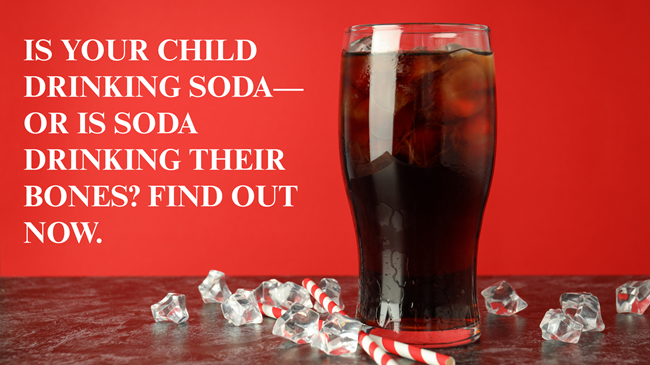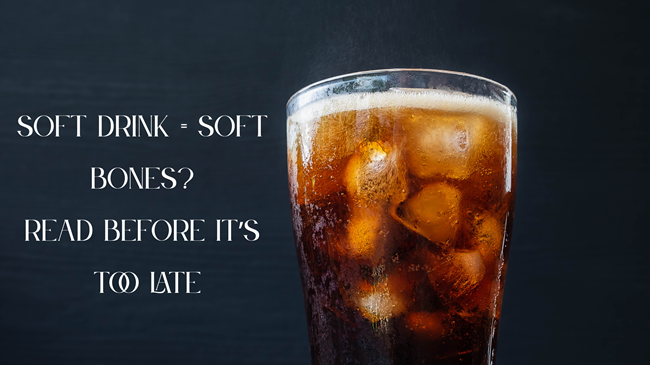The Eye-Opener Most Parents Miss :
As parents, we’re constantly juggling a million things—school schedules, screen time, healthy meals, and more. Somewhere in that chaos, it’s easy to miss the tiny everyday habits that can silently shape our child’s future. One such habit? That chilled can of soda or soft drink we hand over at parties, restaurants, or even just to beat the heat.
It seems harmless, right? After all, it’s just a fizzy drink. But what if I told you that regular soda consumption might be interfering with your child’s growth and bone development?
Yes, you read that right.
In this blog post, we’ll dive deep into how soft drinks can affect your child’s height, bone strength, and long-term health. We’ll explore what scientific research says, explain the biological impact in simple terms, and most importantly—what you can do to make better choices as a parent.

What’s Inside That Can?
To understand how soda impacts kids, we need to first look at what’s inside those colorful cans and bottles:
- High Sugar Content: Most soft drinks are loaded with added sugar, sometimes more than 8-10 teaspoons in a single can.
- Phosphoric Acid: Common in colas, this acid gives soda its tangy taste.
- Caffeine: Found in many sodas, especially cola-based drinks.
- Zero Nutritional Value: No vitamins, no minerals, no health benefits.
These ingredients, while tasty, can create serious problems when consumed regularly by growing children.
The Science Behind Growth and Bone Health
Children grow rapidly during their early years and teenage phase. This is when their bones are actively developing in size, density, and strength. Nutrition plays a huge role in this.
Calcium and Vitamin D are the two most essential nutrients for bone growth. When your child doesn’t get enough of them, or if their body loses calcium faster than it can absorb, the bones suffer.
Here’s where soda becomes a problem:
- Phosphoric acid can interfere with calcium absorption.
- Caffeine increases calcium excretion through urine.
- High sugar intake leads to poor dietary habits, pushing out healthier options like milk or fruits.
Over time, this creates a calcium deficit—a condition where the body starts pulling calcium from the bones to perform essential functions. Weaker bones, stunted growth, and higher fracture risk are the natural consequences.
What the Studies Say
Multiple scientific studies have raised red flags about soft drink consumption among children and teens:
- A study published in the Archives of Pediatrics & Adolescent Medicine found that teenage girls who drank cola beverages daily had significantly lower bone mineral density.
- Research by Tufts University revealed that every soda consumed daily increased the risk of bone fractures by 14%.
- The American Academy of Pediatrics (AAP) has issued guidelines stating that children should not consume soda regularly, especially those containing caffeine or phosphoric acid.
These aren’t fringe theories. These are conclusions from long-term studies and reputable pediatric and medical organizations.
Real-Life Impact – A Parent’s Perspective
As a parent myself, I used to think a soft drink here and there wouldn’t matter. But when it became a regular habit, I noticed other things following:
- My child was drinking less milk.
- More junk food was creeping into their daily diet.
- Their energy levels fluctuated, and sleep patterns were affected.
After reading through medical advice and speaking to a pediatrician, I made a conscious effort to cut down soda consumption at home. We replaced it with:
- Infused water (fruits and mint)
- Fresh coconut water
- Homemade lemonade with jaggery
- Flavored milk and smoothies
The results? Better appetite, improved digestion, and fewer complaints of fatigue.
What Happens Inside the Body?
Let’s break down the biological impact in simple language:
- Bone Weakening: Soda’s phosphoric acid competes with calcium. When there’s more phosphorus and less calcium, bones become porous and weak.
- Stunted Growth: Poor calcium absorption means bones don’t grow to their full length or strength potential.
- Obesity: High sugar content in sodas leads to weight gain, which in turn puts excess pressure on the bones and joints.
- Hormonal Imbalance: Sugar spikes insulin and other hormones, which can impact growth hormone regulation.
So while soda may not directly “stop growth,” it creates all the conditions necessary to slow it down significantly.
The Dangerous Cycle of Habit
Here’s the thing: kids who develop a soda habit early are more likely to continue it into adulthood. This isn’t just about growth; it’s about lifelong bone health.
Adults who consumed high levels of soda in their childhood are at increased risk of:
- Osteoporosis
- Joint pain and fractures
- Early onset arthritis
Breaking the habit early can have a positive ripple effect throughout their life.
How to Make Healthier Choices
You don’t need to be the food police. Just be smart and subtle. Here are some real-life tested tips:
- Don’t Stock It at Home: If it’s not available, they won’t crave it as often.
- Make Water Fun: Add slices of lemon, orange, or mint leaves.
- Celebrate with Alternatives: On special occasions, use naturally flavored drinks or homemade fruit punch.
- Lead by Example: When kids see parents opting for water over soda, they follow.
- Involve Them in Choices: Let them pick their fruits for smoothies or design their own healthy mocktails.
Remember, you’re not depriving them. You’re giving them a better shot at growing tall, strong, and healthy.
Final Thoughts
As a parent, nothing matters more to me than my child’s well-being. And sometimes, the dangers don’t come with warning labels. Soda may be marketed as cool and refreshing, but the long-term cost on growth and bone health is simply not worth it.
Let’s raise kids who are not just tall in height, but strong in health. Let’s choose water over sugar, strength over convenience, and awareness over marketing.
Because when we know better, we do better.
You May Also Like : 10 Brain Boosting Foods to Pack in Your Child Lunchbox , How to Reduce Screen Time for Kids Without Stress: A Friendly Parent’s Guide
FAQ: Soft Drinks and Your Child’s Growth
Q1: Can drinking soft drinks directly stunt a child’s growth?
ANS : Not directly, but soft drinks can reduce calcium absorption and increase calcium loss due to their phosphoric acid and caffeine content. This indirectly impacts bone development and can affect overall growth in the long term.
Q2: How often is too often when it comes to kids drinking soda?
ANS: Even one soda per day has been associated with lower bone density and higher fracture risk in some studies. Occasional consumption (once or twice a month) is much safer than regular daily or weekly intake.
Q3: Are diet sodas better for children?
ANS: Diet sodas may have less sugar, but they often still contain phosphoric acid and caffeine. They also promote the same habit of preferring artificially sweetened beverages over natural, nutritious options.
Q4: What are healthier alternatives to soft drinks for kids?
ANS: Infused water, coconut water, fresh fruit juices (without added sugar), homemade smoothies, and flavored milk are excellent alternatives.
Q5: My child is a picky eater and loves soda. How can I help them shift to healthier choices?
ANS: Gradual replacement, involving kids in making drinks at home, modeling healthy choices yourself, and avoiding soda purchases can slowly help children transition away from sugary beverages.
Q6: If my child already drinks soda regularly, is it too late to make a change?
ANS: It’s never too late. Reducing or eliminating soda, combined with increasing calcium and vitamin D intake, physical activity, and overall good nutrition, can support healthier bone development and mitigate previous harm.
Q7: Can one-time soda consumption cause any harm?
ANS: One-time or occasional consumption is not likely to cause harm. The risk arises from frequent, long-term consumption during the crucial growing years.
References and Sources:

Hi, I’m Prashant Jain — a curious soul, storyteller, and content creator at heart.I’ve always been drawn to the world of entertainment, travel, sports, health & lifestyle — not just as a writer, but as someone who genuinely lives these experiences. Whether I’m binge-watching the latest OTT series, exploring offbeat spiritual destinations in India, or diving deep into wellness routines and cricket match insights, I love sharing what I discover with like-minded readers.
PopNewsBlend is my way of blending personal journeys with meaningful stories — ones that inform, inspire, and keep you ahead of the curve. Everything I write comes from real observations, hands-on experiences, and a deep passion for understanding the world around us.
Discover more from Popnewsblend
Subscribe to get the latest posts sent to your email.








Pingback: Letting Kids Fail: Why It’s the Best Parenting Strategy for Growth in 2025
Pingback: How Parents Anger Shapes Kids Behaviour - Know Before It's Late